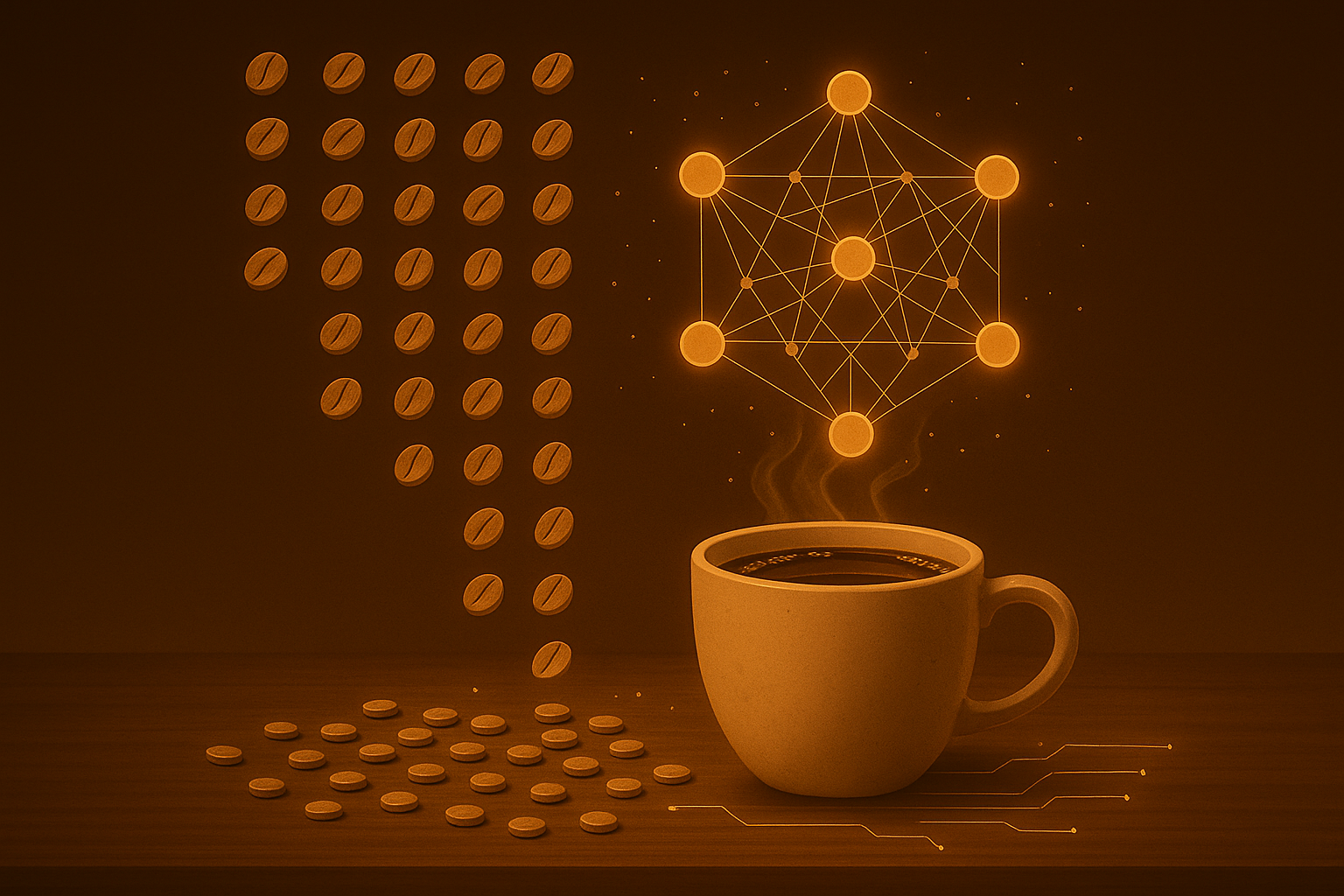
Neural Networks Explained: Why AI Takes 1,000 Tiny Sips Instead of One Big Gulp
I watched my friend take his first sip of a new coffee blend last week. He paused, swirled it around, and immediately said "fruity notes, maybe Ethiopian, medium roast." I asked how he knew all that from one sip.
He laughed. "I didn't. My brain broke down everything - temperature, acidity, sweetness, texture - all at once. Hundreds of tiny observations happening so fast it feels like one thought."
That's exactly how neural networks work.
Why One Big Gulp Doesn't Work
Here's what trips most people up about neural networks. We assume AI looks at a picture of a cat and just "knows" it's a cat, the same way we do. We glance, we recognize, done.
But that's not what's happening under the hood.
Neural networks can't process information in one unified gulp. Instead, they break everything down into thousands of tiny observations, analyze each piece separately, and then reassemble the results. It's like tasting coffee by evaluating every single molecule individually before deciding if you like it.
Seems inefficient, right? But this approach is exactly what makes neural networks so powerful.
The 1,000 Tiny Sips Method
Imagine you're teaching someone to identify great coffee, but they've never tasted it before. You wouldn't just hand them a cup and say "figure it out."
You'd break it down. First sip: notice the temperature. Second sip: focus on bitterness. Third sip: detect sweetness. Fourth sip: feel the texture. You'd have them take hundreds of tiny, focused sips, each one examining a single characteristic.
That's exactly what a neural network does with any information it processes.
When a neural network looks at a photo of your dog, it doesn't see "dog." It sees thousands of tiny details: curved line here, brown pixel there, fuzzy texture in this spot, pointed shape at this angle. Each observation is processed separately through layers of the network.
The first layer might detect basic things like edges and colors - the coffee's temperature and color. The second layer combines those into slightly more complex patterns like shapes and textures - the body and acidity. Deeper layers recognize even more complex features like ears, eyes, or fur patterns - the origin and roast profile.
By the final layer, all those thousands of tiny sips get combined into one conclusion: "This is a Golden Retriever" or "This is a light roast Ethiopian coffee."
Why This Actually Matters
This architecture isn't just a weird quirk of how AI works. It's the reason neural networks can do things that seemed impossible a decade ago.
Because neural networks break everything into tiny observations, they can spot patterns humans miss entirely. A doctor might overlook a subtle shadow in an X-ray, but a neural network trained on thousands of images can detect that particular combination of pixels that indicates early-stage cancer.
It's like having a coffee taster who can consciously evaluate ten thousand aspects of flavor simultaneously. They might notice that beans grown at exactly 1,847 meters with 23% humidity produce a specific acid profile that pairs perfectly with milk. No human could track all those variables, but neural networks can.
This is also why neural networks need so much training data. If you only took ten sips of coffee in your life, you'd have no idea what makes coffee good. But after ten thousand sips, carefully noting every detail? You'd be an expert.
Neural networks are the same. They need thousands or millions of examples to learn which tiny observations matter and which ones are just noise.
The Trade-Off Nobody Mentions
Here's the uncomfortable truth: neural networks are powerful, but they're also black boxes.
When someone tastes coffee, they can tell me exactly why they think it's Ethiopian. "The blueberry notes are characteristic of Yirgacheffe beans, and the bright acidity suggests a light roast."
When a neural network identifies a dog breed, it can't really explain why. It just knows that this particular combination of thousands of tiny observations matches the pattern it learned. The network might be looking at the background instead of the dog, or focusing on unexpected features we'd never consider.
This is why AI researchers talk so much about "interpretability." We can see that neural networks work remarkably well, but understanding exactly why they make specific decisions is still incredibly difficult.
What You Can Do Right Now
You don't need to build a neural network to understand this concept. But recognizing how they work changes how you interact with AI.
When an AI makes a mistake, it's usually because the tiny observations don't match its training. If you've only trained on photos of dogs in parks, you might not recognize a dog on a beach - the sand and water patterns throw off those thousands of tiny sips.
This is why AI systems need diverse training data. It's why chatbots sometimes give weird answers. It's why image recognition fails in unexpected ways. The 1,000 tiny sips method only works if you've tasted enough variety to handle new situations.
Next time you use AI - whether it's photo organization, voice recognition, or content recommendations - remember it's not actually "understanding" anything the way you do. It's breaking everything into microscopic pieces, analyzing each one, and reassembling the results.
The Bottom Line
Neural networks are fascinating not because they think like humans, but precisely because they don't. They're built on a completely different approach: thousands of tiny observations instead of holistic understanding.
This makes them incredibly powerful for pattern recognition. It also makes them fundamentally limited in ways we're still discovering.
Understanding this helps you set realistic expectations for what AI can and can't do. It's not magic. It's just a really sophisticated way of taking 1,000 tiny sips instead of one big gulp.
Pour yourself a coffee and let that sink in for a bit.